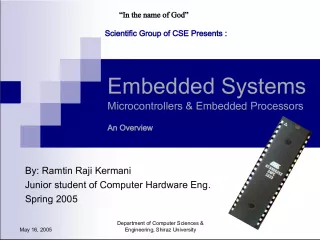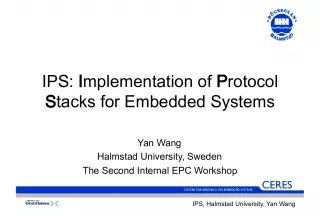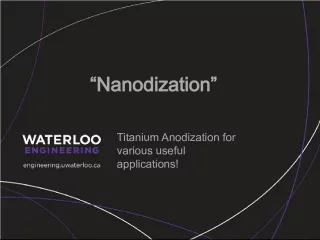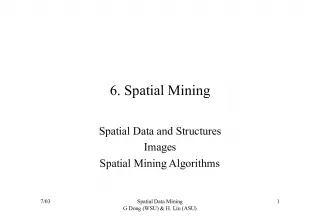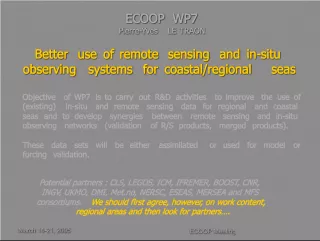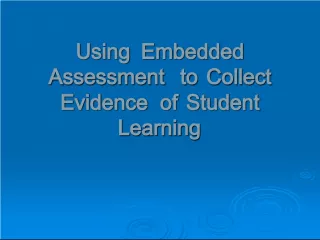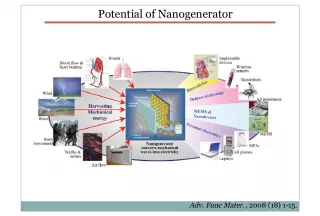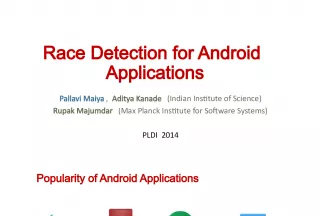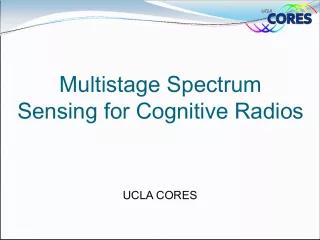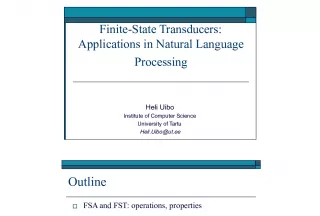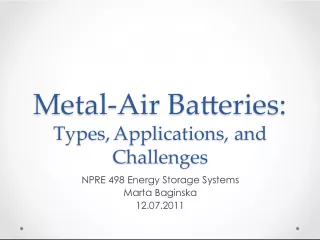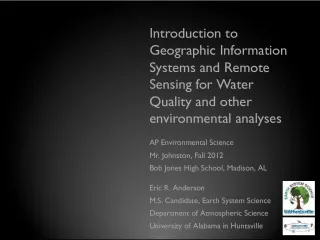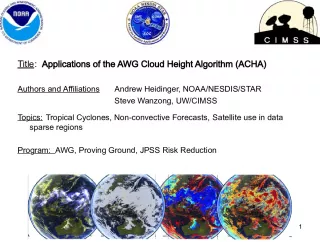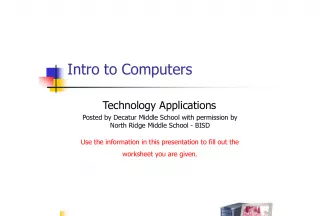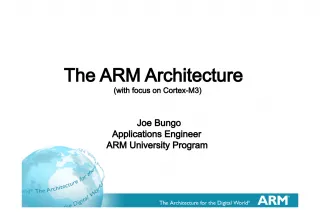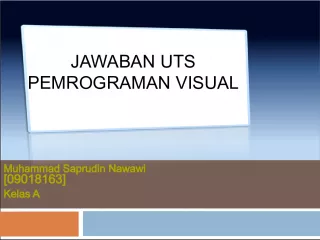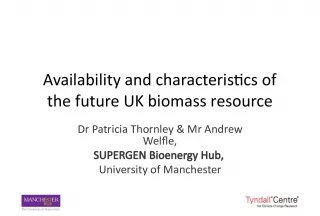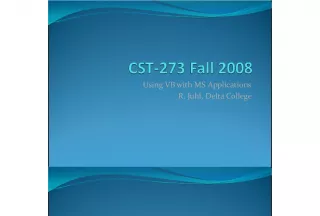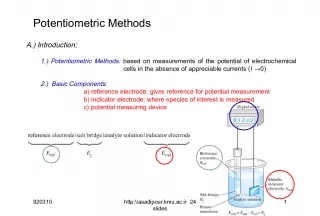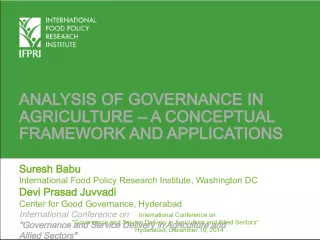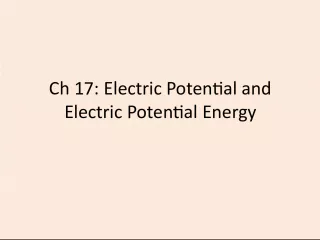Introduction to Embedded Networked Sensing: Potential, Applications, and Challenges


In this presentation, Deborah Estrin starts by providing a brief introduction to the concept of embedded networked sensing, which involves the use of micro sensors, on
- Uploaded on | 6 Views
-
 kairav
kairav
About Introduction to Embedded Networked Sensing: Potential, Applications, and Challenges
PowerPoint presentation about 'Introduction to Embedded Networked Sensing: Potential, Applications, and Challenges'. This presentation describes the topic on In this presentation, Deborah Estrin starts by providing a brief introduction to the concept of embedded networked sensing, which involves the use of micro sensors, on. The key topics included in this slideshow are . Download this presentation absolutely free.
Presentation Transcript
Slide1I-1Part I: Introduction Deborah Estrin
Slide2I-2Outline • Introduction – Motivating applications – Enabling technologies – Unique constraints – Application and architecture taxonomy
Slide3I-3Embedded Networked Sensing Potential • Micro-sensors, on- board processing, and wireless interfaces all feasible at very small scale – can monitor phenomena “up close” • Will enable spatially and temporally dense environmental monitoring • Embedded Networked Sensing will reveal previously unobservable phenomena Seismic Structure response Contaminant Transport Marine Microorganisms Ecosystems, Biocomplexity
Slide4I-4App#1: Seismic • Interaction between ground motions and structure/foundation response not well understood. – Current seismic networks not spatially dense enough to monitor structure deformation in response to ground motion, to sample wavefield without spatial aliasing. • Science – Understand response of buildings and underlying soil to ground shaking – Develop models to predict structure response for earthquake scenarios. • Technology/Applications – Identification of seismic events that cause significant structure shaking. – Local, at-node processing of waveforms. – Dense structure monitoring systems. ENS will provide field data at sufficient densities to develop predictive models of structure, foundation, soil response .
Slide5I-5Field Experiment 1 km • 38 strong-motion seismometers in 17-story steel-frame Factor Building. • 100 free-field seismometers in UCLA campus ground at 100-m spacing
Slide6I-6Research challenges • Real-time analysis for rapid response. • Massive amount of data Smart, efficient, innovative data management and analysis tools. • Poor signal-to-noise ratio due to traffic, construction, explosions, …. • Insufficient data for large earthquakes Structure response must be extrapolated from small and moderate-size earthquakes, and force- vibration testing . • First steps – Monitor building motion – Develop algorithm for network to recognize significant seismic events using real-time monitoring. – Develop theoretical model of building motion and soil structure by numerical simulation and inversion. – Apply dense sensing of building and infrastructure (plumbing, ducts) with experimental nodes.
Slide7I-7App#2: Contaminant Transport • Science – Understand intermedia contaminant transport and fate in real systems. – Identify risky situations before they become exposures. Subterranean deployment. • Multiple modalities (e.g., pH, redox conditions, etc.) • Micro sizes for some applications (e.g., pesticide transport in plant roots). • Tracking contaminant “fronts”. • At-node interpretation of potential for risk (in field deployment). Soil Zone Groundwater Volatization Spill Path Air Emissions Dissolution Water Well
Slide8I-8Contaminant plume ENS Research Implications • Environmental Micro-Sensors – Sensors capable of recognizing phases in air/water/soil mixtures. – Sensors that withstand physically and chemically harsh conditions. – Microsensors. • Signal Processing – Nodes capable of real-time analysis of signals. – Collaborative signal processing to expend energy only where there is risk.
Slide9I-9App#3: Ecosystem Monitoring Science • Understand response of wild populations (plants and animals) to habitats over time. • Develop in situ observation of species and ecosystem dynamics. Techniques • Data acquisition of physical and chemical properties, at various spatial and temporal scales, appropriate to the ecosystem, species and habitat. • Automatic identification of organisms (current techniques involve close-range human observation). • Measurements over long period of time, taken in-situ . • Harsh environments with extremes in temperature, moisture, obstructions, ...
Slide10I-10Field Experiments • Monitoring ecosystem processes – Imaging, ecophysiology, and environmental sensors – Study vegetation response to climatic trends and diseases. • Species Monitoring – Visual identification, tracking, and population measurement of birds and other vertebrates – Acoustical sensing for identification, spatial position, population estimation. • Education outreach – Bird studies by High School Science classes (New Roads and Buckley Schools). Vegetation change detection Avian monitoring Virtual field observations
Slide11I-11ENS Requirements for Habitat/Ecophysiology Applications • Diverse sensor sizes (1-10 cm), spatial sampling intervals (1 cm - 100 m), and temporal sampling intervals (1 s - days), depending on habitats and organisms. • Naive approach Too many sensors Too many data . – In-network, distributed signal processing. • Wireless communication due to climate, terrain, thick vegetation. • Adaptive Self-Organization to achieve reliable, long-lived, operation in dynamic, resource-limited, harsh environment. • Mobility for deploying scarce resources (e.g., high resolution sensors).
Slide12I-12Transportation and Urban Monitoring Disaster Response
Slide13Intelligent Transportation Project (Muntz et al.)
Slide14Smart Kindergarten Project:Sensor-based Wireless Networks of Toys for Smart Developmental Problem-solving Environments (Srivastava et al) Sensors Modules High-speed Wireless LAN (WLAN) WLAN-Piconet Bridge Piconet WLAN-Piconet Bridge WLAN Access Point Piconet Sensor Management Sensor Fusion Speech Recognizer Database & Data Miner Middleware Framework Wired Network Network Management Networked Toys Sensor Badge
Slide15I-15Enabling Technologies Embedded Networked Sensing Control system w/ Small form factor Untethered nodes Exploit collaborative Sensing, action Tightly coupled to physical world Embed numerous distributed devices to monitor and interact with physical world Network devices to coordinate and perform higher-level tasks Exploit spatially and temporally dense, in situ, sensing and actuation
Slide16I-16Sensors • Passive elements: seismic, acoustic, infrared, strain, salinity, humidity, temperature, etc. • Passive Arrays: imagers (visible, IR), biochemical • Active sensors: radar, sonar – High energy, in contrast to passive elements • Technology trend: use of IC technology for increased robustness, lower cost, smaller size – COTS adequate in many of these domains; work remains to be done in biochemical
Slide17I-17Some Networked Sensor Node Developments LWIM III UCLA, 1996 Geophone, RFM radio, PIC, star network AWAIRS I UCLA/RSC 1998 Geophone, DS/SS Radio, strongARM, Multi-hop networks Processor WINS NG 2.0 Sensoria, 2001 Node development platform; multi- sensor, dual radio, Linux on SH4, Preprocessor, GPS UCB Mote, 2000 4 Mhz, 4K Ram 512K EEProm, 128K code, CSMA half-duplex RFM radio
Slide18I-18Sensor Node Energy Roadmap 2000 2002 2004 2000 2002 2004 10,000 10,000 1,000 1,000 100 100 10 10 1 1 .1 .1 Average Power (mW) • Deployed (5W) • PAC/C Baseline (.5W) • (50 mW) (1mW) Rehosting to Low Power COTS Rehosting to Low Power COTS (10x) (10x) -System-On-Chip -System-On-Chip -Adv Power Management -Adv Power Management Algorithms (50x) Algorithms (50x) Source: ISI & DARPA PAC/C Program
Slide19I-19Comparison of Energy Sources With aggressive energy management, ENS might With aggressive energy management, ENS might live off the environment. live off the environment. Source: UC Berkeley
Slide20I-20Communication/Computation Technology Projection Assume: 10kbit/sec. Radio, 10 m range. Assume: 10kbit/sec. Radio, 10 m range. Large cost of communications relative to computation continues Large cost of communications relative to computation continues Source: ISI & DARPA PAC/C Program
Slide21I-21“The network is the sensor” (Oakridge National Labs) Requires robust distributed systems of thousands of physically-embedded, unattended, and often untethered, devices.
Slide22I-22New Design Themes • Long-lived systems that can be untethered and unattended – Low-duty cycle operation with bounded latency – Exploit redundancy and heterogeneous tiered systems • Leverage data processing inside the network – Thousands or millions of operations per second can be done using energy of sending a bit over 10 or 100 meters (Pottie00) – Exploit computation near data to reduce communication • Self configuring systems that can be deployed ad hoc – Un-modeled physical world dynamics makes systems appear ad hoc – Measure and adapt to unpredictable environment – Exploit spatial diversity and density of sensor/actuator nodes • Achieve desired global behavior with adaptive localized algorithms – Cant afford to extract dynamic state information needed for centralized control
Slide23I-23From Embedded Sensing to Embedded Control • Embedded in unattended “control systems” – Different from traditional Internet, PDA, Mobility applications – More than control of the sensor network itself • Critical applications extend beyond sensing to control and actuation – Transportation, Precision Agriculture, Medical monitoring and drug delivery, Battlefied applications – Concerns extend beyond traditional networked systems • Usability, Reliability, Safety • Need systems architecture to manage interactions – Current system development: one-off, incrementally tuned, stove- piped – Serious repercussions for piecemeal uncoordinated design: insufficient longevity, interoperability, safety, robustness, scalability...
Slide24I-24Sample Layered Architecture Resource constraints call for more tightly integrated layers Open Question: Can we define an Internet-like architecture for such application- specific systems?? In-network: Application processing, Data aggregation, Query processing Adaptive topology, Geo-Routing MAC, Time, Location Phy: comm, sensing, actuation, SP User Queries, External Database Data dissemination, storage, caching
Slide25I-25• Spatial and Temporal Scale – Extent – Spatial Density (of sensors relative to stimulus) – Data rate of stimulii • Variability – Ad hoc vs. engineered system structure – System task variability – Mobility (variability in space) • Autonomy – Multiple sensor modalities – Computational model complexity • Resource constraints – Energy, BW – Storage, Computation Systems Taxonomy • Frequency – spatial and temporal density of events • Locality – spatial, temporal correlation • Mobility – Rate and pattern Load/Event Models Metrics • Efficiency – System lifetime/System resources • Resolution/Fidelity – Detection, Identification • Latency – Response time • Robustness – Vulnerability to node failure and environmental dynamics • Scalability – Over space and time
